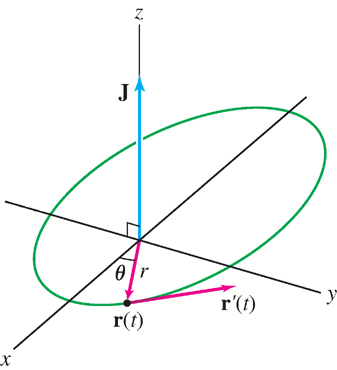Kepler’s Second Law
The key to Kepler’s Second Law is the fact that the following cross product is a constant vector (even though both r(t) and r′(t) are changing in time):

THEOREM 1
The vector J is constant—

In physics, mJ is called the angular momentum vector. In situations where J is constant, we say that angular momentum is conserved. This conservation law is valid whenever the force acts in the radial direction.
767
Proof
By the Product Rule for cross products (Theorem 3 in Section 13.2)

The cross product of parallel vectors is zero, so the second term is certainly zero. The first term is also zero because r″(t) is a multiple of er by Eq. (1), and hence also of r(t).
REMINDER
a × b is orthogonal to both a and b
a × b = 0 if a and b are parallel, that is, one is a multiple of the other.
How can we use Eq. (2)? First of all, the cross product J is orthogonal to both r(t) and r′(t). Because J is constant, r(t) and r′(t) are confined to the fixed plane orthogonal to J. This proves that the motion of a planet around the sun takes place in a plane.
We can choose coordinates so that the sun is at the origin and the planet moves in the counterclockwise direction (Figure 4). Let (r, θ) be the polar coordinates of the planet, where r = r(t) and θ = θ(t) are functions of time. Note that r(t) = ∥r(t)∥.

Recall from Section 11.4 (Theorem 1) that the area swept out by the planet’s radial vector is

Kepler’s Second Law states that this area is swept out at a constant rate. But this rate is simply dA/dt. By the Fundamental Theorem of Calculus,  , and by the Chain Rule,
, and by the Chain Rule,

Thus, Kepler’s Second Law follows from the next theorem, which tells us that dA/dt has the constant value  .
.
THEOREM 2
Let J = ∥J∥ (J is constant by Theorem 1). Then

Proof
We note that in polar coordinates, er = 〈cos θ, sin θ〉. We also define the unit vector eθ = 〈−sin θ, cos θ〉 that is orthogonal to er (Figure 5). In summary,


We see directly that the derivatives of er and eθ with respect to θ are

The time derivative of er is computed using the Chain Rule:

Now apply the Product Rule to r = rer:

768
Using er × er = 0, we obtain
J = r × r′ = rer × (r′er + rθ′eθ) = r2θ′(er × eθ)
To compute cross products of vectors in the plane, such as r, er, and eθ, we treat them as vectors in three-
It is straightforward to check that er × eθ = k, and since k is a unit vector, J = ∥J∥ = |r2θ′|. However, θ′ > 0 because the planet moves in the counterclockwise direction, so J = r2θ′. This proves Theorem 2.